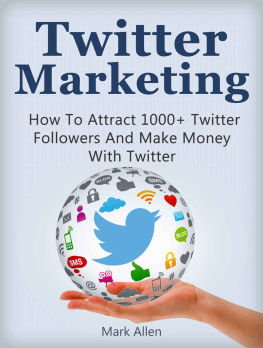Twitter
Digital Media and Society
Nancy Baym: Personal Connections in the Digital Age
Jean Burgess and Joshua Green: YouTube 2nd edition
Mark Deuze: Media Work
Charles Ess: Digital Media Ethics
Alexander Halavais: Search Engine Society
Martin Hand: Ubiquitous Photography
Robert Hassan: The Information Society
Tim Jordan: Hacking
Leah Lievrouw: Alternative and Activist New Media
Rich Ling and Jonathan Donner: Mobile Communication
Donald Matheson and Stuart Allan: Digital War Reporting
Dhiraj Murthy: Twitter
Zizi Papacharissi: A Private Sphere
Jill Walker Rettberg: Blogging
Patrik Wikstrm: The Music Industry
Twitter
Social Communication in the Twitter Age
D HIRAJ M URTHY
polity
Copyright Dhiraj Murthy 2013
The right of Dhiraj Murthy to be identified as Author of this Work has been asserted in accordance with the UK Copyright, Designs and Patents Act 1988.
First published in 2013 by Polity Press
Polity Press
65 Bridge Street
Cambridge CB2 IUR, UK
Polity Press
350 Main Street
Maiden, MA 02148, USA
All rights reserved. Except for the quotation of short passages for the purpose of criticism and review, no part of this publication may be reproduced, stored in a retrieval system, or transmitted, in any form or by any means, electronic, mechanical, photocopying, recording or otherwise, without the prior permission of the publisher.
ISBN: 978-0-7456-6510-8
A catalogue record for this book is available from the British Library.
The publisher has used its best endeavours to ensure that the URLs for external websites referred to in this book are correct and active at the time of going to press. However, the publisher has no responsibility for the websites and can make no guarantee that a site will remain live or that the content is or will remain appropriate.
Every effort has been made to trace all copyright holders, but if any have been inadvertently overlooked the publisher will be pleased to include any necessary credits in any subsequent reprint or edition.
For further information on Polity, visit our website: www.politybooks.com
For Kalpana, Deya Anjali, and Akash
Dedicated in loving memory of Nagavenamma and Venkatachala Shetty
Youre not reducing face-to-face time... You dont choose to stay in and do Twitter. Its like those spare moments on the Web when Im doing another task I switch over to Twitter for literally 15 seconds. There is no fewer face-to-face, no fewer phone calls, theres more awareness of other people in my life and maybe that even leads to further conversation with some people.
Evan Williams, co-founder of Twitter
(cited in Niedzviecki 2009:132)
Contents
8 Conclusion
F IGURES
T ABLE
What Hath God Wrought Samuel Morses first message, on May 24, 1844, on the newly completed telegraph wire linking Baltimore and Washington was a mere 21 characters long. Alexander Graham Bells first message on the telephone to his lab assistant on March 10, 1876, Mr. Watson come here I want to see you, was more liberal: 42 characters long. And 95 years later, Ray Tomlinson sent the first email, with the message QWERTYUIOP, from one computer in Cambridge, Massachusetts, to another computer sitting beside it. Tomlinsons message: a spartan 10 characters.
In the past, technology determined the length and duration of the message. In the Internet age of today, our ability to communicate is seemingly limitless. But the computer has ushered in a new era of brevity. Twitter is a digital throwback to the analog succinctness of telegrams. Yet what is the significance of this electronically diminished turn to terseness? Does it signal the dumbing down of society, the victory of short attention spans, or the rise of new virtual me cultures? Are we saying more with less, or just saying less? Or perhaps we are saying more about less. This position is well illustrated by status updates, short one- or two-line messages on the popular social networking website Facebook. Though these short messages are often trivially banal (e.g., mustard dripping out of my bagel sandwich), they are elevated to news, which Facebook automatically distributes to your group of friends, selected individuals who have access to your Facebook profile, that is, your personalized web page on the site. Once the update percolates to your friends, they have the opportunity to comment on your update, generating a rash of discussion about dripping mustard, and so on.
This form of curt social exchange has become the norm with messages on Twitter, the popular social media website where individuals respond to the question Whats happening? with a maximum of 140 characters. These messages, known as tweets, can be sent through the Internet, mobile devices such as Internet-enabled phones and iPads, and text messages. But, unlike status updates, their strict limit of 140 characters produces at best eloquently terse responses and at worst heavily truncated speech. Tweets such as gonna see flm tonite! or jimmy wil be fired 18r 2day are reflective of the latter. The first tweet on the site, just setting up my twttr (24 characters), by Jack Dorsey, the creator of Twitter, on March 21, 2006, perhaps led by example. This book emphasizes that Dorseys message, like that of Morse, was brief and, like that of Bell, was unremarkable setting up ones Twitter and asking the recipient to return.
By drawing this line between the telegraph and telephone to Twitter, this book makes its central argument that the rise of these messages does not signal the death of meaningful communication. Rather, Twitter has the potential to increase our awareness of others and to augment our spheres of knowledge, tapping us into a global network of individuals who are passionately giving us instant updates on topics and areas in which they are knowledgeable or participating in real-time. In doing so, however, the depth of our engagements with this global network of people and ideas can also, sometimes, become more superficial. Many of us would be worried if Twitter replaced traditional media or the longer-length media of blogs, message boards, and email lists. The likelihood of this is, of course, minimal and this book concludes with the suggestion that there is something profoundly remarkable in us being able to follow minute-by-minute commentary in the aftermath of an earthquake, or even the break-up of a celebrity couple. This book is distinctive in not only having Twitter as its main subject, but also its approach of theorizing the site as a collection of communities of knowledge, ad hoc groups where individual voices are aggregated into flows of dialog and information (whether it be Michael Jacksons death or the release of the Lockerbie bomber). Ultimately, Twitter affords a unique opportunity to re-evaluate how communication and culture can be individualistic and communal simultaneously.
I also describe how these changes in communication are not restricted exclusively to the West, as any mobile phone, even the most basic model, is compatible with Twitter. Tweets can be quickly and easily sent, a fact that has led to the exponential growth of its base to over 140 million users worldwide (Wasserman 2012). This has been useful in communicating information about disasters (e.g., the 2011 Thoku earthquake in Japan) and social movements (e.g., the 2011 Arab Spring movements). At an individual level, tweets have reported everything from someones cancer diagnosis to unlawful arrests. For example, in April 2008, James Karl Buck, a graduate student at the University of California, Berkeley, was arrested photographing an anti-government labor protest in Mahalla, Egypt. He quickly sent a one-word tweet from his phone, arrested, which caught the attention of Bucks Twitter followers, those who subscribe to his tweets. His one-word tweet led to Berkeley hiring a lawyer and Bucks eventual release. There are, of course, many distinctions to be made between the tweets sent by Buck, or those sent during the Mumbai bomb blasts, and the more unremarkable, everyday tweets. Contrast the tweet Prasad Naik sent moments after the Mumbai bomb blasts, Firing happening at the Oberoi hotel where my sister works. Faaak! with Jack Dorseys third tweet, wishing I had another sammich. Though an intentionally striking and loaded comparison, it is just this absurdity that happens daily, hourly, and by the minute on Twitter. This combination of banal/profound, combined with the one-to-many explicitly public broadcasting of tweets, differentiates Twitter from Facebook and text messages.
Next page










